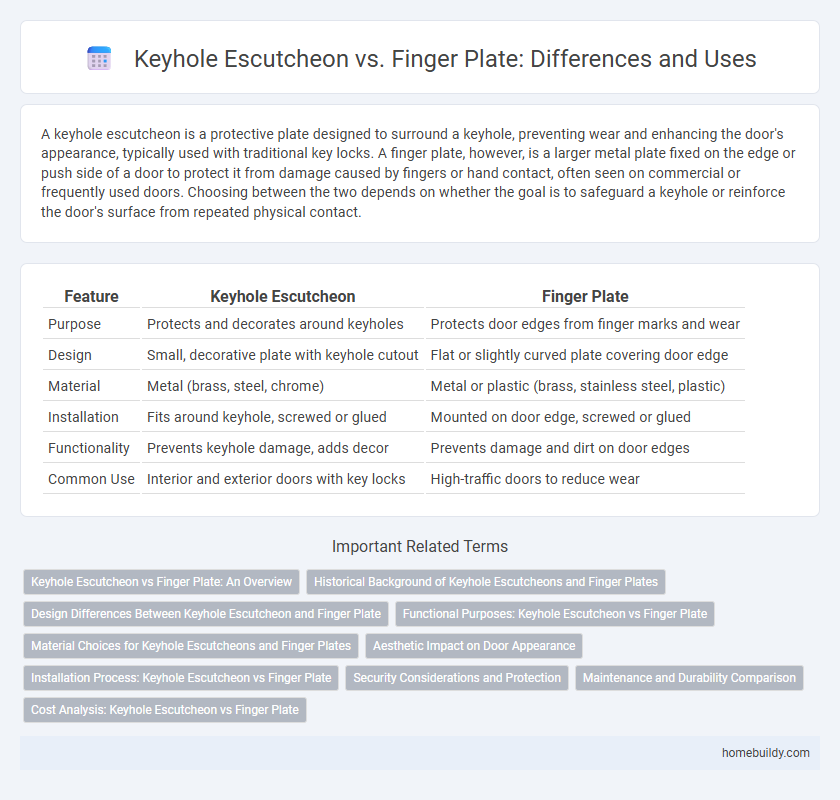A keyhole escutcheon is a protective plate designed to surround a keyhole, preventing wear and enhancing the door's appearance, typically used with traditional key locks. A finger plate, however, is a larger metal plate fixed on the edge or push side of a door to protect it from damage caused by fingers or hand contact, often seen on commercial or frequently used doors. Choosing between the two depends on whether the goal is to safeguard a keyhole or reinforce the door's surface from repeated physical contact.
Table of Comparison
| Feature | Keyhole Escutcheon | Finger Plate |
|---|---|---|
| Purpose | Protects and decorates around keyholes | Protects door edges from finger marks and wear |
| Design | Small, decorative plate with keyhole cutout | Flat or slightly curved plate covering door edge |
| Material | Metal (brass, steel, chrome) | Metal or plastic (brass, stainless steel, plastic) |
| Installation | Fits around keyhole, screwed or glued | Mounted on door edge, screwed or glued |
| Functionality | Prevents keyhole damage, adds decor | Prevents damage and dirt on door edges |
| Common Use | Interior and exterior doors with key locks | High-traffic doors to reduce wear |
Keyhole Escutcheon vs Finger Plate: An Overview
Keyhole escutcheons offer precise protection and aesthetic framing for keyholes, enhancing door security and visual appeal. Finger plates provide reinforcement against wear where fingers push doors open but lack the central keyhole protection characteristic of escutcheons. Choosing between a keyhole escutcheon and a finger plate depends on the door's design priorities, whether focusing on keyhole security or finger guard functionality.
Historical Background of Keyhole Escutcheons and Finger Plates
Keyhole escutcheons date back to the 17th century, originally designed to protect wooden doors from keyhole wear and to conceal the lock mechanism, embodying both function and ornate craftsmanship. Finger plates emerged later during the Industrial Revolution, reflecting a shift towards utilitarian design focused on protecting door surfaces from finger marks and wear. While keyhole escutcheons highlight historical locksmith artistry, finger plates represent evolving industrial practicality in door hardware.
Design Differences Between Keyhole Escutcheon and Finger Plate
Keyhole escutcheons feature a narrow, precise opening designed specifically to accommodate key insertion, emphasizing security and functional precision in door hardware. Finger plates, by contrast, are broader, flat plates that protect door surfaces from finger marks and wear, focusing on durability and ergonomic design rather than key access. The design differences highlight the escutcheon's role in locking mechanisms, while finger plates serve primarily as protective and tactile elements on doors.
Functional Purposes: Keyhole Escutcheon vs Finger Plate
Keyhole escutcheons provide a protective and decorative surround for keyholes, preventing wear on the door surface and concealing lock mechanisms, while allowing smooth key access. Finger plates serve a different functional purpose by protecting the door area around the handle or keyhole from finger marks, scratches, and wear during frequent use. Both components enhance door durability but fulfill distinct roles in managing access points and user interaction.
Material Choices for Keyhole Escutcheons and Finger Plates
Keyhole escutcheons are commonly crafted from durable metals such as brass, stainless steel, and zinc alloy, offering resistance to wear and corrosion while providing elegant finishes suitable for both traditional and modern doors. Finger plates, often made from similar metals, may also incorporate materials like aluminum for lightweight applications, emphasizing protection against door handle damage rather than aesthetic enhancement. While both components prioritize robust materials, keyhole escutcheons focus more on precise cutouts and decorative detailing around keyholes, whereas finger plates emphasize larger surface area coverage to shield door surfaces from finger marks and wear.
Aesthetic Impact on Door Appearance
Keyhole escutcheons create a sophisticated and elegant look by highlighting the keyhole with a decorative metal plate, enhancing traditional or vintage door designs. Finger plates offer a minimalist and functional aesthetic, protecting areas around the handle without interrupting the door's clean lines. Choosing between a keyhole escutcheon and a finger plate significantly influences the door's visual appeal, balancing decorative detail against modern simplicity.
Installation Process: Keyhole Escutcheon vs Finger Plate
The installation process of a keyhole escutcheon involves precise alignment with the keyhole on the door, often requiring screws to securely fasten the plate and ensure smooth key access. In contrast, installing a finger plate typically focuses on protecting the door surface from finger marks and may only require simple screw placement or adhesive attachment without the need for key alignment. Keyhole escutcheons demand more careful measuring to avoid obstructing the lock mechanism, whereas finger plates prioritize durability and ease of installation on flat door surfaces.
Security Considerations and Protection
Keyhole escutcheons provide enhanced protection by covering the keyhole, reducing access for tampering and picking tools, which significantly improves door security. Finger plates, while useful for preventing wear around the keyhole, offer minimal resistance to forced entry or lock manipulation. Choosing a keyhole escutcheon is essential for increasing security by shielding vulnerable lock components from direct exposure.
Maintenance and Durability Comparison
Keyhole escutcheons typically require less maintenance than finger plates due to their simpler design and fewer moving parts, reducing wear and tear. Manufactured from robust materials such as brass or stainless steel, keyhole escutcheons exhibit high durability, resisting corrosion and physical damage effectively. Finger plates, while offering better protection against finger marks, may need more frequent cleaning and replacement in high-traffic areas because of surface wear.
Cost Analysis: Keyhole Escutcheon vs Finger Plate
Keyhole escutcheons generally offer a more cost-effective solution compared to finger plates, with lower manufacturing and installation expenses due to their simpler design and smaller material requirements. Finger plates, while typically more durable and decorative, tend to have higher upfront costs and may require more maintenance over time, increasing their total cost of ownership. Choosing between the two depends on balancing initial budget constraints against long-term durability and aesthetic preferences.
Keyhole escutcheon vs Finger plate Infographic

 homebuildy.com
homebuildy.com